Cupressus sempervirens (cypress)
 Cupressus sempervirens, the Mediterranean cypress (also known as Italian cypress, Tuscan cypress, graveyard cypress, or pencil pine), is a species cypress native to the eastern Mediterranean region, in Libya, Albania, Croatia, Greece, Turkey, Cyprus, Egypt, Syria, Lebanon, Israel, Malta, Italy, Jordan and Iran.
Cupressus sempervirens, the Mediterranean cypress (also known as Italian cypress, Tuscan cypress, graveyard cypress, or pencil pine), is a species cypress native to the eastern Mediterranean region, in Libya, Albania, Croatia, Greece, Turkey, Cyprus, Egypt, Syria, Lebanon, Israel, Malta, Italy, Jordan and Iran.
Damiana
 Turnera diffusa, known as damiana, is a shrub native to southern Texas in the United States, Central America, Mexico, South America, and the Caribbean. It belongs to the family Passifloraceae. Damiana is a relatively small, woody shrub that produces small, aromatic flowers. It blossoms in early to late summer and is followed by fruits that taste similar to figs. Read more
Turnera diffusa, known as damiana, is a shrub native to southern Texas in the United States, Central America, Mexico, South America, and the Caribbean. It belongs to the family Passifloraceae. Damiana is a relatively small, woody shrub that produces small, aromatic flowers. It blossoms in early to late summer and is followed by fruits that taste similar to figs. Read more
Elemi
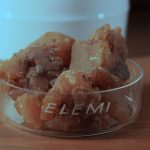 Elemi - Canarium is a genus of about 100 species of tropical and subtropical trees, in the family Burseraceae. They grow naturally across tropical Africa, south and southeast Asia, Indochina, Malesia, Australia and western Pacific Islands; including from southern Nigeria east to Madagascar, Mauritius, Sri Lanka and India;Read more
Elemi - Canarium is a genus of about 100 species of tropical and subtropical trees, in the family Burseraceae. They grow naturally across tropical Africa, south and southeast Asia, Indochina, Malesia, Australia and western Pacific Islands; including from southern Nigeria east to Madagascar, Mauritius, Sri Lanka and India;Read more
Galbanum
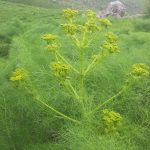 Galbanum is an aromatic gum resin and a product of certain umbelliferous Persian plant species in the genus Ferula, chiefly Ferula gummosa (synonym F. galbaniflua) and Ferula rubricaulis. Galbanum-yielding plants grow plentifully on the slopes of the mountain ranges of northern Iran. Read more
Galbanum is an aromatic gum resin and a product of certain umbelliferous Persian plant species in the genus Ferula, chiefly Ferula gummosa (synonym F. galbaniflua) and Ferula rubricaulis. Galbanum-yielding plants grow plentifully on the slopes of the mountain ranges of northern Iran. Read more
Grapefruit (Citrus paradisi)
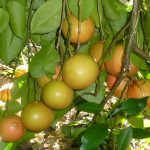 The grapefruit (Citrus × paradisi) is a subtropical citrus tree known for its relatively large sour to semi-sweet, somewhat bitter fruit. Grapefruit is a citrus hybrid originating in Barbados as an accidental cross between two introduced species – sweet orange (C. sinensis), and pomelo (or shaddock) (C. maxima) – both of which were introduced from Asia in the seventeenth century.Read more
The grapefruit (Citrus × paradisi) is a subtropical citrus tree known for its relatively large sour to semi-sweet, somewhat bitter fruit. Grapefruit is a citrus hybrid originating in Barbados as an accidental cross between two introduced species – sweet orange (C. sinensis), and pomelo (or shaddock) (C. maxima) – both of which were introduced from Asia in the seventeenth century.Read more
Guaiacum
 Guaiacum denotes a genus of the zygomatic family (Zygophyllaceae). It contains six to eight tree species from tropical and subtropical America. Guaiacum species are trees or shrubs with very hard, resin-rich wood. There are six to eight species in the genus of guaiac trees (Guaiacum) in tropical and warmer America: Guaiacum angustifolium - Mexico and Texas; Guaiacum coulteri - Mexico; Guaiacum unijungum - Baja California in Mexico; Guaiacum officinale L. - Antilles and the north coast of South America.Read more
Guaiacum denotes a genus of the zygomatic family (Zygophyllaceae). It contains six to eight tree species from tropical and subtropical America. Guaiacum species are trees or shrubs with very hard, resin-rich wood. There are six to eight species in the genus of guaiac trees (Guaiacum) in tropical and warmer America: Guaiacum angustifolium - Mexico and Texas; Guaiacum coulteri - Mexico; Guaiacum unijungum - Baja California in Mexico; Guaiacum officinale L. - Antilles and the north coast of South America.Read more
Hieracium
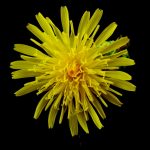 Hieracium , known by the common name hawkweed and classically as hierakion (from ancient Greek ιεράξ, hierax ‘hawk’), is a genus of the sunflower (Helianthus) family Asteraceae), and closely related to dandelion (Taraxacum), chicory (Cichorium), prickly lettuce (Lactuca) and sow thistle (Sonchus), which are part of the tribe Cichorieae. Hawkweeds, with their 10,000+ recorded species and subspecies, do their part to make Asteraceae the second largest family of flowers. Some botanists group all these species or subspecies into approximately 800 accepted species, while others prefer to accept several thousand species. Hieracium species are native to Africa, Asia, Europe, North America, Central America and South America.
Hieracium , known by the common name hawkweed and classically as hierakion (from ancient Greek ιεράξ, hierax ‘hawk’), is a genus of the sunflower (Helianthus) family Asteraceae), and closely related to dandelion (Taraxacum), chicory (Cichorium), prickly lettuce (Lactuca) and sow thistle (Sonchus), which are part of the tribe Cichorieae. Hawkweeds, with their 10,000+ recorded species and subspecies, do their part to make Asteraceae the second largest family of flowers. Some botanists group all these species or subspecies into approximately 800 accepted species, while others prefer to accept several thousand species. Hieracium species are native to Africa, Asia, Europe, North America, Central America and South America.
Juniperus communis
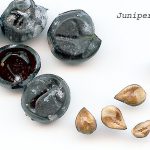 Juniperus communis is a species in the genus Juniperus, in the family Cupressaceae. It has the largest range of any woody plant, throughout the cool temperate Northern Hemisphere from the Arctic south in mountains to around 30°N latitude in North America, Europe and Asia. Read more
Juniperus communis is a species in the genus Juniperus, in the family Cupressaceae. It has the largest range of any woody plant, throughout the cool temperate Northern Hemisphere from the Arctic south in mountains to around 30°N latitude in North America, Europe and Asia. Read more
Labdanum
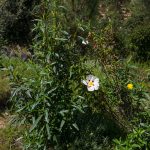 Labdanum, also called ladanum, laudanum, ladan or ladanon, is a sticky brown resin obtained from the shrubs Cistus ladanifer (western Mediterranean) and Cistus creticus (eastern Mediterranean), species of rockrose. It has a long history of use in herbal medicine and as a perfume ingredient.Read more
Labdanum, also called ladanum, laudanum, ladan or ladanon, is a sticky brown resin obtained from the shrubs Cistus ladanifer (western Mediterranean) and Cistus creticus (eastern Mediterranean), species of rockrose. It has a long history of use in herbal medicine and as a perfume ingredient.Read more
Laurus nobilis
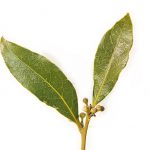 Laurus nobilis or laurel is an aromatic evergreen with green, glossy leaves, native to the Mediterranean region. Laurel can vary greatly in size and height, sometimes reaching 10 to 18 metres. It is widely used in a wide variety of recipes, particularly in the Mediterranean kitchen, and for medical treatments. In ancient Greece (Daphne is the Greek name for the tree) and Roman culture it was a symbol of victory and highest status, today it gives still the name to an academical degree. In the Bible laurel is often an emblem of prosperity and fame, in Christian tradition, it symbolizes the resurrection of Christ.Read more
Laurus nobilis or laurel is an aromatic evergreen with green, glossy leaves, native to the Mediterranean region. Laurel can vary greatly in size and height, sometimes reaching 10 to 18 metres. It is widely used in a wide variety of recipes, particularly in the Mediterranean kitchen, and for medical treatments. In ancient Greece (Daphne is the Greek name for the tree) and Roman culture it was a symbol of victory and highest status, today it gives still the name to an academical degree. In the Bible laurel is often an emblem of prosperity and fame, in Christian tradition, it symbolizes the resurrection of Christ.Read more
Lavandula angustifolia (Lavender)
 Lavandula (common name lavender) is a genus of 47 known species of flowering plants in the mint family, Lamiaceae. It is native to the Old World and is found from Cape Verde and the Canary Islands, Europe across to northern and eastern Africa, the Mediterranean, southwest Asia, China (Plectranthus mona lavender) to southeast India.Read more
Lavandula (common name lavender) is a genus of 47 known species of flowering plants in the mint family, Lamiaceae. It is native to the Old World and is found from Cape Verde and the Canary Islands, Europe across to northern and eastern Africa, the Mediterranean, southwest Asia, China (Plectranthus mona lavender) to southeast India.Read more
Lemon
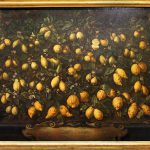 The lemon, Citrus limon, is a species of small evergreen tree in the flowering plant family Rutaceae, native to South Asia, primarily North eastern India. The tree’s ellipsoidal yellow fruit is used for culinary and non-culinary purposes throughout the world, primarily for its juice, which has both culinary and cleaning uses. Read more
The lemon, Citrus limon, is a species of small evergreen tree in the flowering plant family Rutaceae, native to South Asia, primarily North eastern India. The tree’s ellipsoidal yellow fruit is used for culinary and non-culinary purposes throughout the world, primarily for its juice, which has both culinary and cleaning uses. Read more
Myrrh
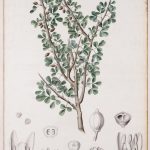 Myrrh is a natural gum or resin extracted from a number of small, thorny tree species of the genus Commiphora. Myrrh resin has been used throughout history as a perfume, incense, and medicine. Myrrh mixed with wine can also be ingested. Commiphora myrrha is native to Somalia, Oman, Yemen, Eritrea, (Somali Region) of Ethiopia and parts of Saudi Arabia. Read more
Myrrh is a natural gum or resin extracted from a number of small, thorny tree species of the genus Commiphora. Myrrh resin has been used throughout history as a perfume, incense, and medicine. Myrrh mixed with wine can also be ingested. Commiphora myrrha is native to Somalia, Oman, Yemen, Eritrea, (Somali Region) of Ethiopia and parts of Saudi Arabia. Read more
Neroli
 Neroli oil is an essential oil produced from the blossom of the bitter orange tree (Citrus aurantium subsp. amara or Bigaradia). Its scent is sweet, honeyed and somewhat metallic with green and spicy facets. Orange blossom is also extracted from the same blossom and both extracts are extensively used in perfumery. Orange blossom can be described as smelling sweeter, warmer and more floral than neroli. The difference between how neroli and orange blossom smell and why they are referred to with different names, is a result of the process of extraction that is used to obtain the oil from the blooms. Read more
Neroli oil is an essential oil produced from the blossom of the bitter orange tree (Citrus aurantium subsp. amara or Bigaradia). Its scent is sweet, honeyed and somewhat metallic with green and spicy facets. Orange blossom is also extracted from the same blossom and both extracts are extensively used in perfumery. Orange blossom can be described as smelling sweeter, warmer and more floral than neroli. The difference between how neroli and orange blossom smell and why they are referred to with different names, is a result of the process of extraction that is used to obtain the oil from the blooms. Read more

 Deutsch
Deutsch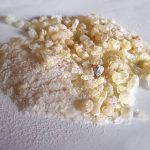 Dammar is the resin of deciduous trees from the family of the wing crops that grow in India and on the Sunda Islands in the Malay Archipelago. Dammar is also produced in Indonesia, Papua New Guinea and the Philippines.
Dammar is the resin of deciduous trees from the family of the wing crops that grow in India and on the Sunda Islands in the Malay Archipelago. Dammar is also produced in Indonesia, Papua New Guinea and the Philippines.